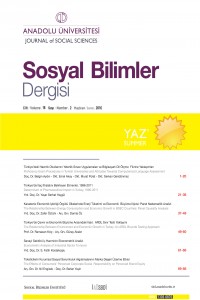Öz
Bu çalışmanın amacı; ekonomik büyüme ile çevre arasındaki ilişkiyi incelemektir. Bu amaçla, Çevresel Kuznets Eğrisi hipotezinin (ÇKE) 1960-2011 dönemi için Türkiye’de geçerliliği test edilmiştir. Ekonomik büyüme göstergesi olarak Kişi Başına Düşen Milli Gelir, çevre kirliliği göstergesi olarak da Kişi Başına Karbondioksit (CO2) emisyonu kullanılmıştır. Ayrıca kontrol değişkeni olarak da ticari dışa açıklık oranı modele dahil edilmiştir. ARDL (The Autoregressive Distributed Lag) modeli ile elde edilen bulgular şöyle sıralanabilir: i) Kuadratik model için elde edilen uzun dönemli katsayılara göre, kişi başına gelir ile çevre kirliliği arasında ters U şeklinde bir ilişkinin mevcut olduğu görülmektedir. Bu sonuç ÇKE hipotezinin 1960-2011 döneminde Türkiye’de geçerli olduğunu desteklemektedir. ii) Kubik model için elde edilen uzun dönemli katsayılara göre, gelir ile çevre kirliliği arasında N şeklinde bir ilişki mevcuttur.
Anahtar Kelimeler
Kaynakça
- Akbostancı, E., Türüt, A. S., Tunç, G. İ. (2009). The Relationship Between Income and Environment in Turkey: Is there An Environmental Kuznets Curve?. Energy Policy, 37, 861-867.
- Atıcı, C., Kurt, F. (2007). Türkiye’nin Dış Ticareti ve Çevre Kirliliği: Çevresel Kuznets Eğrisi Yaklaşımı. Tarım Ekonomisi, 13(2), 61 - 69.
- Aslan, F. (2010). İktisadi Büyümenin Sınırları ve Kalkınmanın Sürüdürülebilirliği. (Yayınlamış Yüksek Lisans Tezi), Ankara Üniversitesi/ Sosyal Bilimler Enstitüsü, Ankara
- BahmanI-Oskooee, M., Raymond, C.W.N.G. (2002). Longrun Demand for Money in Hong Kong: An Application of The ARDL Model. International Journal of Business and Economics, 1(2), 147–155.
- Başar, S., Temurlenk, M.S. (2007). Çevreye Uyarlanmış Kuznet Eğrisi: Türkiye Üzerine Bir Uygulama. İktisadi ve İdari Bilimler Dergisi, 21(1) 1-12.
- Brown, R.L., James, D., Jonathan, M.E. (1975). Techniques for Testing the Constancy of Regression Relationships over Time. Journal of the Royal Statistical Society, 37(2),149-192.
- Bölük, G., Mert, M. (2015). The Renewable Energy, Growth and Environmental Kuznets Curve in Turkey: An ARDL Approach. Renewable and Sustainable Energy Reviews, 52, 587-595.
- Çiftlikli, M. (2011). Çevre Kirliliğinin Ekonomik Boyutları. Çevre Dergisi, 7, 46-48.
- Dam, M.M., Karakaya, E., Bulut, Ş. (2013). Çevresel Kuznets Eğrisi ve Türkiye :Ampirik Bir Analiz. Dumlupınar Üniversitesi Sosyal Bilimler Dergisi, EYİ 2013 Özel Sayısı, 85-96.
- Dickey, D., Fuller, W.A. (1981). Likelihood Ratio Statistics for Autoregressive Time Series with a Unit Root, Econometrica, 49, 1057-72.
- Erdem, E., Ulucak, R. (2012). Çevre İktisat İlişkisi ve Türkiye’de Çevre Politikalarının Etkinliği. Akademik Araştırmalar ve Çalışmalar Dergisi, 6, 78-98.
- Erdoğan, İ., Türköz, K., Görüş, M.Ş. (2015). Çevresel Kuznets Eğrisi Hipotezinin Türkiye Ekonomisi İçin Geçerliliği. Dumlupınar Üniversitesi Sosyal Bilimler Dergisi, 44, 113-123.
- Engle, R.F., Granger, C.W.J. (1987). Cointegration and Error Correction: Representation, Estimation and Testing. Econometrica, 55, 251–76.
- Granger, C.W.J., Newbold, P. (1974). Spurios Regressions in Econometrics. Journal of Econometrics, 2, 111–120.
- Grossman, G.M., Alan, B.K. (1991). Environmental Impacts of a North American Free Trade Agreement. National Bureau of Economics Research Working Paper, No. 3194, NBER, Cambridge.
- Johansen, S., Juselius, K. (1990). Maximum Likelihood Estimation and Inference on Cointegration - with Applications to The Demand for Money. Oxford Bulletin of Economics and Statistics, 52, 169-210.
- Johansen, S. (1988). Statistical Analysis of Cointegration Vectors. Journal of Economic Dynamics and Control, 12, 231-254.
- Koçak, E. (2014). Türkiye’de Çevresel Kuznets Eğrisi Hipotezinin Geçerliliği: ARDL Sınır Testi Yaklaşımı. İşletme ve İktisat Çalışmaları Dergisi, 3, 62-73.
- Kuznets, S. (1955). Economic Growth and Income Inequality. American Economic Review, 45(1), 1-28.
- Martin, L.C. (2002). The Environmental Kuznets Curve –A Survey of The Empirical Evidence and of Possible Causes. Discussion Paper Series No:390, Switzerland.
- Narayan, P.K., (2005). The Savings and Investment Nexus for China: Evidence from Cointegration Test. Applied Economics, 91, 1979–1990.
- Pesaran, M.H., Shin, Y., Smith, R.J. (2001). Bounds Testing Approaches to The Analysis of Level Relationships. Journal of Applied Econometrics, 16, 289 – 326.
- Pesaran, M.H., Shin, Y. (1999). An Autoregressive Distributed Lag Modeling Approach to Cointegration Analysis. The Ragnar Frisch Centennial Symposium. Ch. 11. Cambridge: Cambridge University Press.
- Pesaran, M.H., Shin, Y., Smith, R.J. (2000), Structural Analysis of Vector Error Correction Models with Exogenous I(1) Variables. Journal of Econometrics, 97, 293-343.
- Phillips, P.C.B., Perron, P. (1988). Testing for A Unit Root in Time Series Regression, Biometrika, 75, 335–346.
- Saatci, M., Dumrul, Y. (2012). The Relationship Between Economic Growth and Environmental Pollution: The Estimation of Environmental Kuznets Curve with A Cointegratıon Analysis of Structural Breaks for Turkish Economy. Erciyes University, Journal of the Faculty of Economics and Administrative Sciences, 37,65-86.
- Soytaş, U., Sarı, R. (2009). Energy Consumption, Economic Growth, and Carbon Emissions: Challenges Faced by an EU Candidate Member. Ecological Economics, 68, 1667–1675.
- Şahinöz, A., Fotourehchi, Z. (2013). Çevresel Kuznet Eğrisi: İndirgenmiş ve Ayrıştırılmış Modellerle Ampirik Bir Analiz. H.Ü. İktisadi ve İdari Bilimler Fakültesi Dergisi, 31 (1), 199-224.
- Tutulmaz, O. (2011). Ekonomi- Çevre İlişkisi ve Sürüdülebilir Kalkınma : Ampirik Bir Değerlendirme. (Yayınlanmış Doktora Tezi), Hacettepe Üniversitesi/ Sosyal Bilimler Enstitüsü, Ankara.
Ayrıntılar
| Birincil Dil | Türkçe |
|---|---|
| Bölüm | Makaleler |
| Yazarlar | |
| Yayımlanma Tarihi | 12 Ağustos 2016 |
| Gönderilme Tarihi | 13 Kasım 2015 |
| Yayımlandığı Sayı | Yıl 2016 Cilt: 16 Sayı: 2 |
Cited By
RENEWABLE ENERGY AND CO₂ EMISSIONS: A CASE STUDY OF TURKIYE (1985-2022)
Akademik Yaklaşımlar Dergisi
https://doi.org/10.54688/ayd.1514919
İklim Değişikliği Ekonomik Büyüme ve Gıda Fiyatları Döngüsü: Türkiye Örneği
Adam Akademi Sosyal Bilimler Dergisi
https://doi.org/10.31679/adamakademi.1179375
Türkiye’de Çevresel Kuznets Eğrisinin Genişletilmiş Sınır Testi (A-ARDL) Yardımıyla Sınanması: 1970-2021 Dönemi
Cumhuriyet Üniversitesi İktisadi ve İdari Bilimler Dergisi
https://doi.org/10.37880/cumuiibf.1334231
Finansal Gelişme, İnovasyon ve CO2 Emisyonları: ARDL Sınır Testi Yaklaşımı
Econder International Academic Journal
https://doi.org/10.35342/econder.1269394
Sürdürülebilir Kalkınma için Çevre Kirliliği ile İlişkilendirilen Faktörlerin Belirlenmesi: Panel Veri Analizi
Afyon Kocatepe Üniversitesi Sosyal Bilimler Dergisi
https://doi.org/10.32709/akusosbil.1081596
TÜRK BANKACILIK SEKTÖRÜNDEKİ YÜZEN FONLARIN OPTİMAL DÜZEYİNİN BELİRLENMESİ
Muhasebe Bilim Dünyası Dergisi
https://doi.org/10.31460/mbdd.462966
İmalat Sanayi Üretimi ile Çevresel Kirlilik İlişkisi: Türkiye İçin Çevresel Kuznets Eğrisi Hipotezinin Geçerliliği
BİLTÜRK Journal of Economics and Related Studies
https://doi.org/10.47103/bilturk.1195741
Türkiye’de Gelir, Enerji Tüketimi, Ticari Açıklık ve Çevre Koruma Harcamaları: ÇKE Hipotezinin Bölgesel Analizi
International Journal of Public Finance
https://doi.org/10.30927/ijpf.1013985
TÜRKİYE’DE KARBON EMİSYONLARI, YENİLENEBİLİR ENERJİ VE EKONOMİK BÜYÜME
Ege Stratejik Araştırmalar Dergisi
Bilge Kağan OZDEMİR
https://doi.org/10.18354/esam.665191
Bu eser Creative Commons Atıf-GayriTicari 4.0 Uluslararası Lisansı ile lisanslanmıştır.


